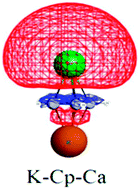Static second hyperpolarizability of inverse sandwich compounds (M1–C5H5–M2) of alkali (M1 = Li, Na, K) and alkaline earth metals (M2 = Be, Mg, Ca)†
Abstract
In the investigated inverse sandwich complexes, charge transfer from alkali metal (M1) led to aromatically stabilized Cp ring, which prevented further charge transfer from the alkaline earth metal (M2). This electron push effect resulted in diffusion of electron density from the outermost “ns” subshell of alkaline earth metal. The alkaline earth metal is weakly bound to the alkali metal–C5H5 complex. The vertical ionization energy of the chosen M1–Cp–M2 complexes was smaller than that of the corresponding alkaline earth metals. Large second hyperpolarizability (106–108 a.u.) was obtained for the studied molecules. The correction due to the basis set superposition error (BSSE) in the calculated second hyperpolarizability was found to be small for larger systems, while it was rather significant for small systems. The MP4SDQ and CCSD results were in fair agreement, which indicates the necessity of higher order electron correlation treatment in the accurate description of second hyperpolarizability. Calculated dynamic second hyperpolarizabilities at 1064 nm were found to increase considerably for most of the chosen metal complexes.



 Please wait while we load your content...
Please wait while we load your content...